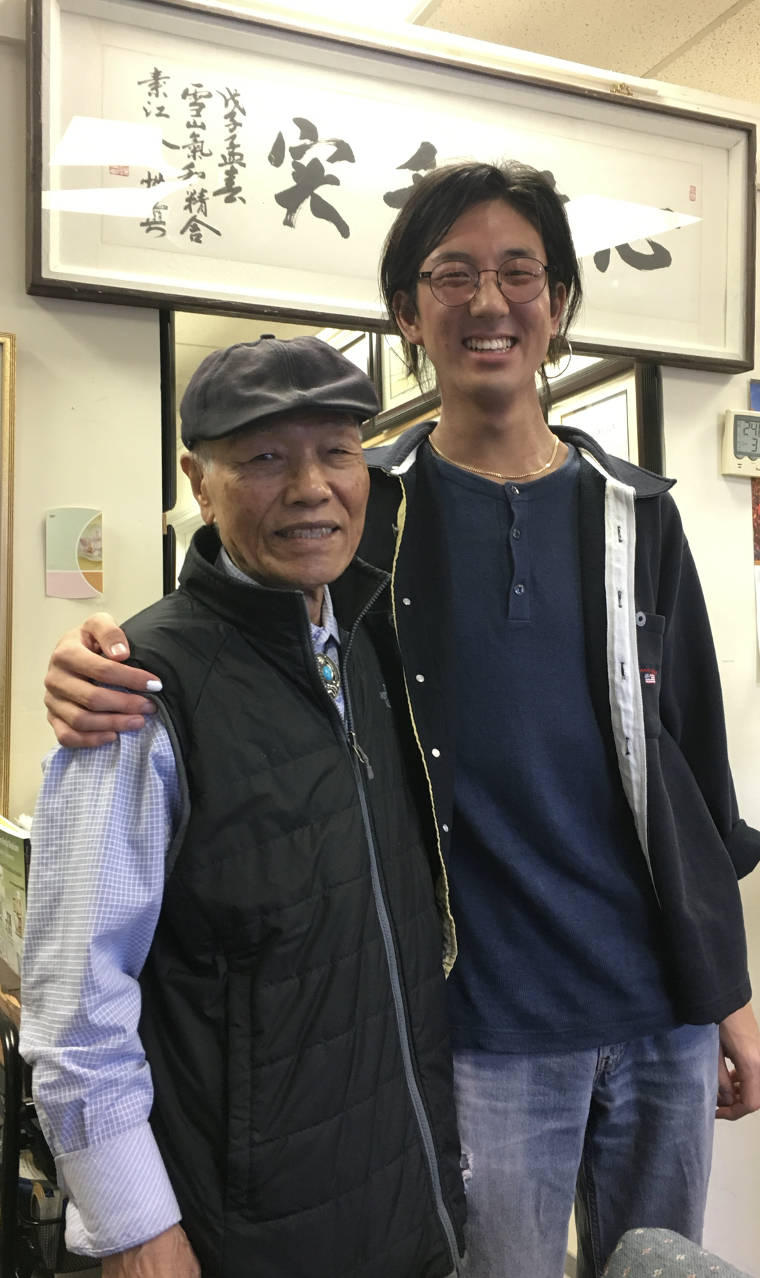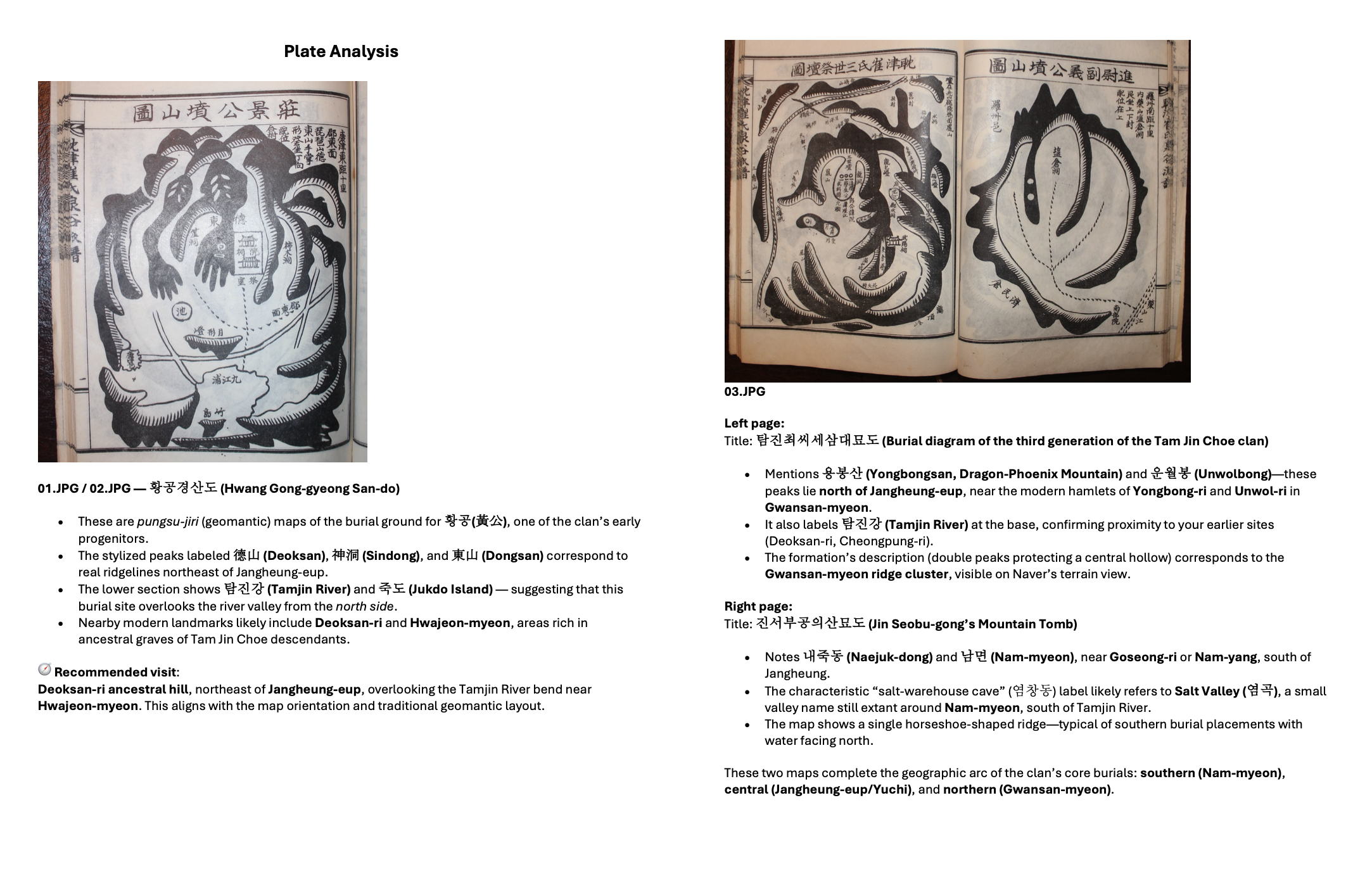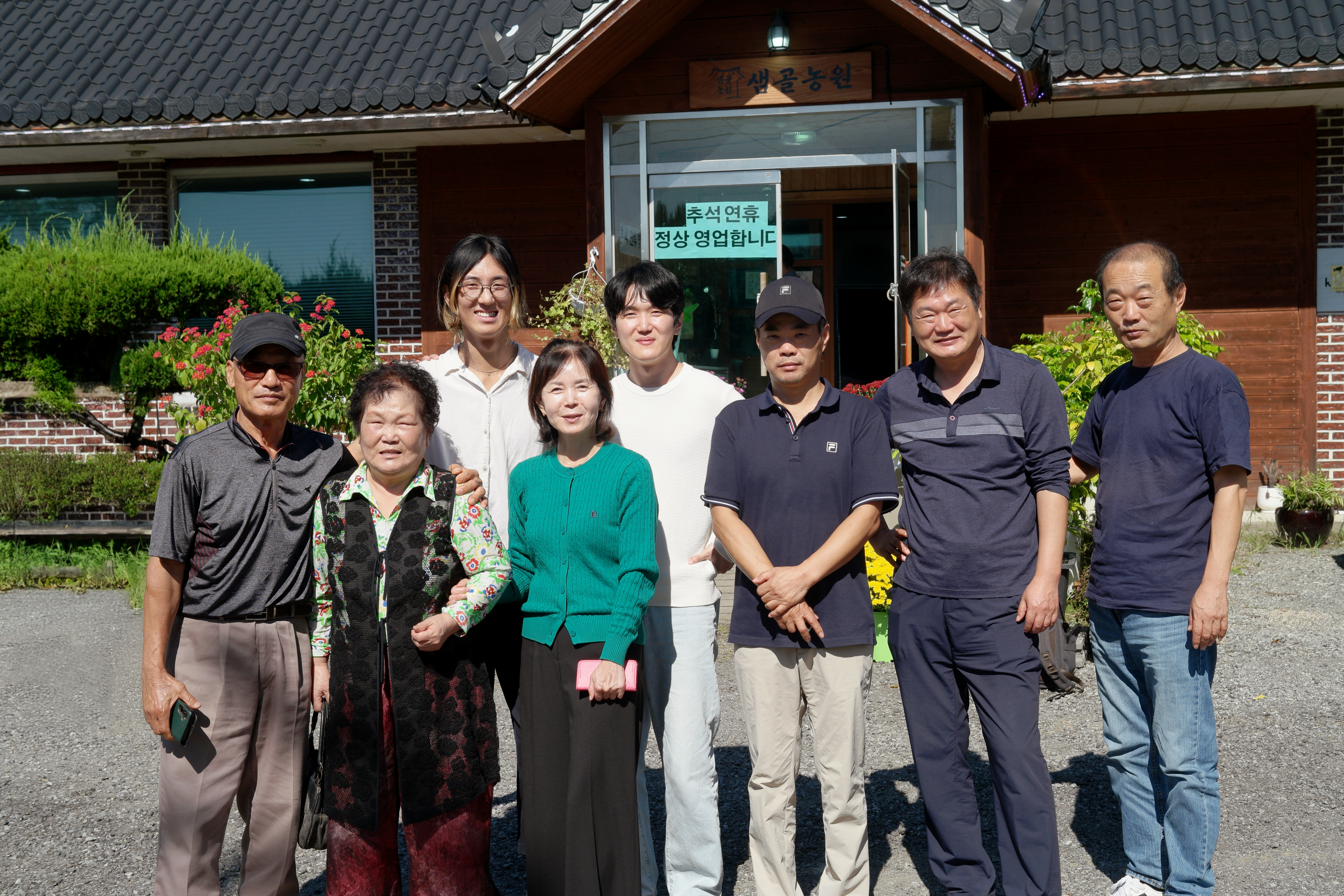October 2025
(Kor / 한국어 Version)
Overview
On October 10-12, 2025, I went on a trip from Seoul to Gwangju to conduct fieldwork on my patrilineal ancestry, the Tamjin Choe Ssi clan. On Day 1, I met with 8 family members for lunch, a ceremonial cemetery visit, and conversation at a traditional teahouse. On Day 2, my cousin Gyungdeok drove me an hour south to Tamjingang, my patrilineal clan's ancestral river, and its surrounding areas. In between these activities, I explored places significant to my father's youth before he emigrated to the United States in the late 1970s, as well as memorial places relevant to the 1980 Gwangju Democratic Movement (광주민주화운동).

1. Seoul, 2. Gwangju, 3. Tamjin River
Haraboji's Death
On Christmas Day 2021, Kichin Choe, my paternal grandfather (Haraboji) died from an accidental slip in his apartment. In preparation for his funeral, I authored his obituary, scanned and curated photographs from his life, and prepared a 5 minute video from interview footage that I shot with him in 2013. My mom had helped facilitate the interview, and helped again by translating the interview so I could add English subtitles for the funeral. After the funeral, I assisted in clearing Haraboji's apartment, looking through his belongings, listing furniture for sale, and reflecting on his life.


Right: me presenting interview footage at Haraboji’s funeral, December 2021

Above: Still from video interview shot in 2013
Jokbo is the key
Since his death, my curiosity in my own Korean ancestry has increased, considering that Haraboji was the last patrilineal relative of his generation that I am in contact with. As a gyopo(person of Korean disapora) who does not speak Korean fluently, I believe that studying the past will guide my future. Furthermore, my work in Hawai'i, which concerns indigenous history and ancestral relationship to land, has encouraged me to understand my own indigeneity as a pre-requisite for making meaningful contributions to a place where I am not native.
I thought that constructing a family tree might help in this effort, and learned of the existence of our family's Jokbo. A Jokbo is a genealogical record that many Korean families possess. It is often the responsibility of the patriarch, who keeps it safe and up to date. For non-Korean readers, you've likely noticed that many Koreans share the same last name (e.g., Kim, Lee, Park). What you might not know, is that there are many geographically-specific clans within these surnames, and even further, specific pa, or sub-clans.
I pestered my extended family, asking where our Jokbo had been relocated to after Haraboji's death. After 3 years (in January 2025), I received it, as well as supplementary print documents that Haraboji had kept with it, including a handwritten genealogical table tracing our descendents back to 852 AD, and miscellaneous documents including request forms to amend our Jokbo with individuals of younger generations. Seeing how fragile and old the book itself is, I can understand why it requires gatekeeping.
Elated, I eagerly photographed the Jokboand all its related documents before returning them to my uncle, and attempted to transcribe the handwritten hanja (Chinese characters used for official Korean documents) using AI tools, to no avail. I was most impressed with a series of 5 illustrations denoting the locations of key ancestors' tombs, which I've since learned are called geomantic maps. Geomantic (pungsu / 풍수) burial maps — stylized representations of mountains, rivers, and tomb locations, showing the auspicious flow of gi (기, energy) in the landscape. These were often included in older Jokbo volumes to mark the resting places of key ancestors and illustrate the geomantic “dragon veins” (용맥 / 龍脈).
My mom helped me translate the cover of the Jokbo, which spelled out Tamjin Choe Ssi. Based on internet searches, I learned that our clan has Wikipedia pages detailing notable ancestors, publicly available Jokbos (though of different sub-clans than ours), but most importantly, that we are associated with the Tamjin River. This felt miraculous to me. In Hawai'i, one commonly introduces oneself with which body of water you grew up next to. I grew up next to the Sammamish River, on the land of Coast Salish people, on the eastside of Seattle. I have always been a river person. Last November, on my 30th birthday, my friend Austin and I walked down to the Bogachiel River in the Olympic peninsula, practicing deep listening (what in Hawai'i we call kilo), and I thought about their think-tank known as "River Computer". Rivers are life, and here I was, confronted with this truth on a deep level, filled with the urgent desire to visit my ancestral river (or “bloodshed” as Austin coined). I booked a flight to Korea.
 Left: cover of the Tamjin Choe Ssi Jokbo
Left: cover of the Tamjin Choe Ssi Jokbo Right: genealogical table by Haraboji (in Hanja + English transliteration)
What I came with
In preparation for my trip to my patrilineal ancestral land, I prepared the following.
- Fieldwork Guide: with the help of AI tools, I analyzed the 5 burial maps in our Jokbo, generating a list of significant sites (the Tamjin River being one of them, amongst a series of other mountain ranges, temples, and landmarks), tips for how to find them by their current names and geographic coordinates, and an itinerary for how to most efficiently search for them via car.
- Letter for Gwangju family: on the 2 hour bullet train ride south, I learned that my cousin had arranged a lunch with all of our significant relatives in the area. Anticipating the language barrier, I carefully wrote a long letter to my relatives, explaining my intentions for the visit as well as information about myself (the last time we met was 10 years ago) and translated it to Korean, which my cousin agreed to help me deliver. I also created a powerpoint with relevant photos, as well as the interview video of my Haraboji that I had screened at his funeral - knowing that his sister and cousin would be in attendance at this lunch.
- Paternal Sites: I asked my father and uncle for recommendations of places to visit in Gwangju, and received the locations of where they spent time during elementary school, and where my Haraboji went to high school.
- 1980 Gwangju Democratic Movement Sites: I identified memorial parks and cultural centers where I could learn more about this revolutionary moment in Korean history.
- Tools: I prepared my digital camera and journal.
 Selection from the fieldwork guide I prepared in advance of the trip
Selection from the fieldwork guide I prepared in advance of the tripImpressions
-
Warm reception: It was deeply moving to spend time with relatives who I
hadn't seen in over 10 years. Generally, their response to my curiosity in our
shared ancestral history was amused, bewildered, grateful, and generous. They
remarked how uncommon it is for young people to take an interest in this kind
of stuff. One of my uncles warmly grasped my hand and thanked me, for caring,
and taking the effort to come visit them in this way. They gave me a round of
applause after my cousin finished reading aloud my letter.
-
Familial piety: I like to think that I am fulfilling
a familial piety to my patrilineal relatives in Korea, as no one else in my nuclear
family is in touch with them. Keeping bonds alive that otherwise will wither. I
have heard that in Korean culture, it is the eldest male of the generation who
is responsible for the Jokbo, and whose bloodline continues the family
tree. I like to think that by virtue of not being the eldest male of my
generation, and claiming this responsibility for my generation, I am
simultaneously honoring a tradition that spans millennia, while making an
intervention to replace its concern with age and gender, with different
criteria -- passion, attention, care. I wonder who in the next generation of
our family will be interested in accepting this responsibility.
-
What my relatives said: Due to my lacking Korean skills, I picked up very little
as my relatives spoke at lightspeed after my presentation, diving into deep
family histories. I retained a few things - that my 2nd Grandma really does
look like her brother, my Haraboji! That they think the TamjinRiver is less significant to understanding my heritage - that knowing 2-3
generations back is sufficient. Our family's burial grounds are outside of
Gwangju after all, and my Grandfather's family is from Bia (비아), not the Tamjin
River (which is over an hour drive south from there). Light insinuations
that the American side of our family, including my Haraboji, should have
done, or could do more, to carry on this family history.
-
Embodied experience: Walking along the Tamjin with
my cousin, I crossed some stepping stones into the middle of the river looking
north. I took off my shoes and socks and submerged my feet into the river. I
sat like this for a few minutes, in sensorial observation (kilo) and awe
that this was really happening. That my body was in contact with the body of
water that sustained my earliest ancestors. I touched my fingers to the river
and pressed them to my lips. A generational handshake across millennia. If I
was expecting some kind of psychedelic epiphany or spiritual channeling,
nothing like that happened. It was a peaceful moment, not unlike many other
moments I've had with bodies of water. More than anything, it felt like an
exciting first encounter (of what I hope will be many more), with this
version of god.

Lunch with the Gwangju family


What I'm leaving with
- Photo Documentation: visit to Gwangju cemetery, Dad’s childhood places (elementary school and bridge where he used to play), Tamjin River, and Deoksan-ri (a reservoir fed by the Tamjin, with surrounding mountains that are depicted in one of the Jokbo illustrations)
- Audio Documentation: I took a voice memo of my Great Uncle Ilsoo, who seems to have the deepest knowledge of the Tamjin Choe Ssi clan, whose oration on our family history I could not understand in real time. Will try to transcribe and translate later.
- Jokbo page in Hangeul: Great Uncle Ilsoo provided me his own version of the genealogical table that my Haraboji had created -- formatted slightly differently, and notably, in hangeul (Korean alphabet), rather than in Hanja (Chinese characters).
- Offer from Great Uncle Ilsoo: I seem to have an open invitation to contact him and ask questions as needed via KakaoTalk (Korea's instant messenger app) - though I haven't heard back from him yet.
 Genealogical table in Korean by Great Uncle Ilsoo
Genealogical table in Korean by Great Uncle IlsooNext Steps
-
Digitally
reconstruct the Jokbo: Now that I have the genealogical table in Korean
characters, this will help me in creating a digital version that I can share
with my American relatives, keep up to date, and pass on to the next
generation.
-
Future
Trip: On
my next trip to Korea (which I hope to take a year from now), I will rent a car
and accommodations near the Tamjin River. Our visit was on a Sunday, and
the town offices were closed. I will need to bring my documents and maps to a
town official or village elder, who can help make connections between old names
and new ones, and point me in the right direction to actually discover the
burial sites of key ancestors, rather than just be near them. I may need an
interpreter. Perhaps I'll make a creative project out of it, or maybe it will
just be a meditative pilgrimage that I take from time to time, for the rest of
my life.
Conclusion: "Go South"
Driving around the Tamjin, I wondered what had led the first settlers to this area, so far south on the Korean peninsula, nearly at the ocean. While I have little evidence, all signs point towards the fertile river valley as an ideal location for agriculture, fishing, and proximity to the ocean for diving and trade.
The day before the trip, I spent the day with my friends In and Terri, who read my Saju for me (birth chart / fortune). This generated 24 pages of analysis, which felt revelatory in its clarity and precision, compared to the murkier encounters I've had with western astrology and tarot. A key part of my Saju is that I have a complete lack of "fire" in my chart. It prescribes me to "Go South", to warmer climates, to concern myself with heated, embodied activations (exercise, dance). To surround myself with warm friends who are spontaneous, positive, excited about life.

Saju consists of 8 characters that define your destiny
I have always known these things, but it felt like an epiphany considering the following:
-
My
ancestors had "gone south" (nearly as far as they could go) to
settle the area that would become the land base for my clan.
-
I
had "gone south" from Seoul to search for my roots, mirroring this
journey on bullet train rather than on foot, wagon, or horseback.
- In my adult life, I have repeatedly "gone south", from my original northern territories (Seattle, New York City), to southern territories (Hawai'i, South Carolina). Hawai'i Island, where I live now, is home to the southernmost point of the United States (literally called "South Point"). So in this way, like my ancestors, I have also gone as far south as possible in my home country. Hilarious!
Thank you for reading.
Seb